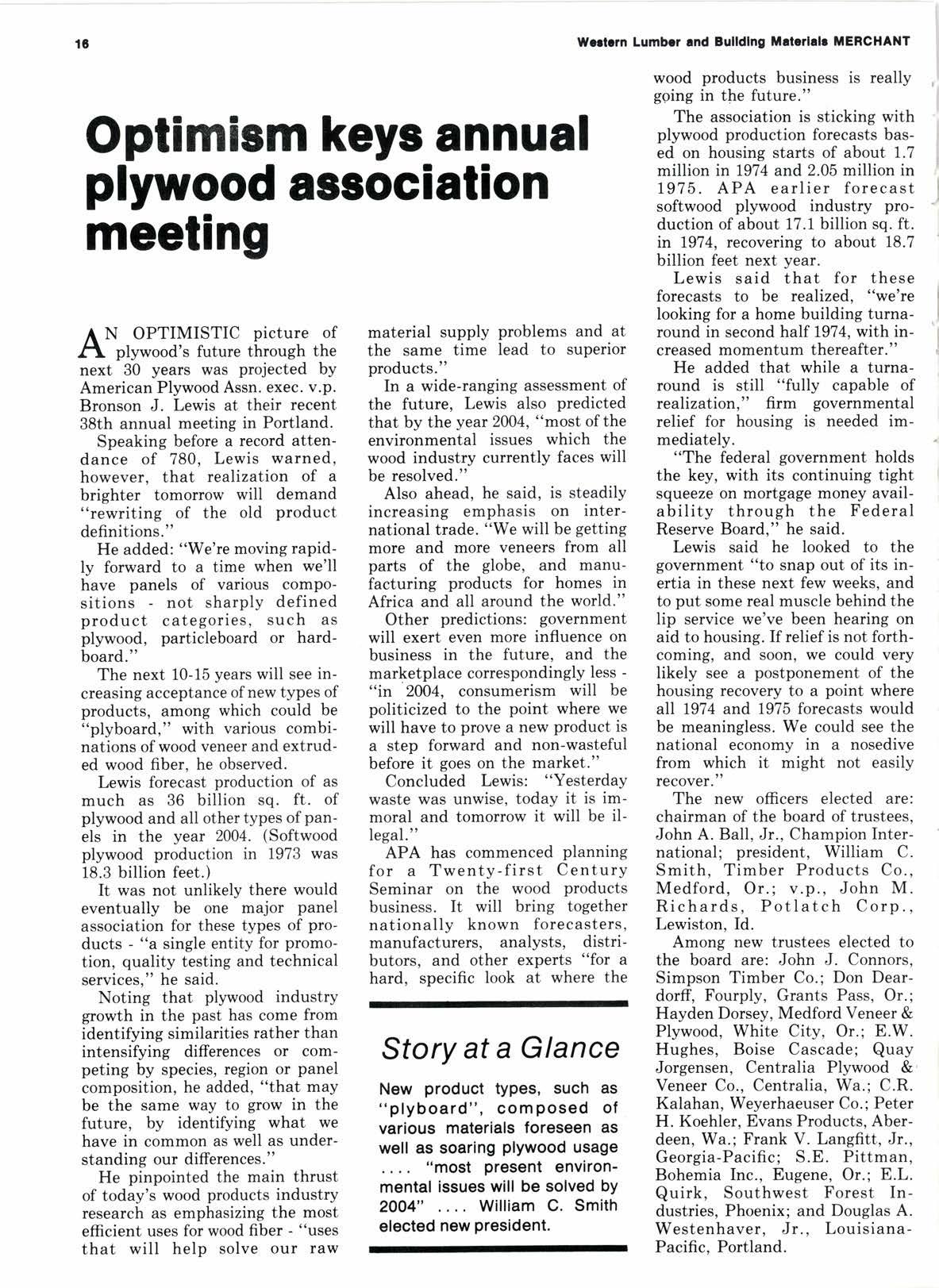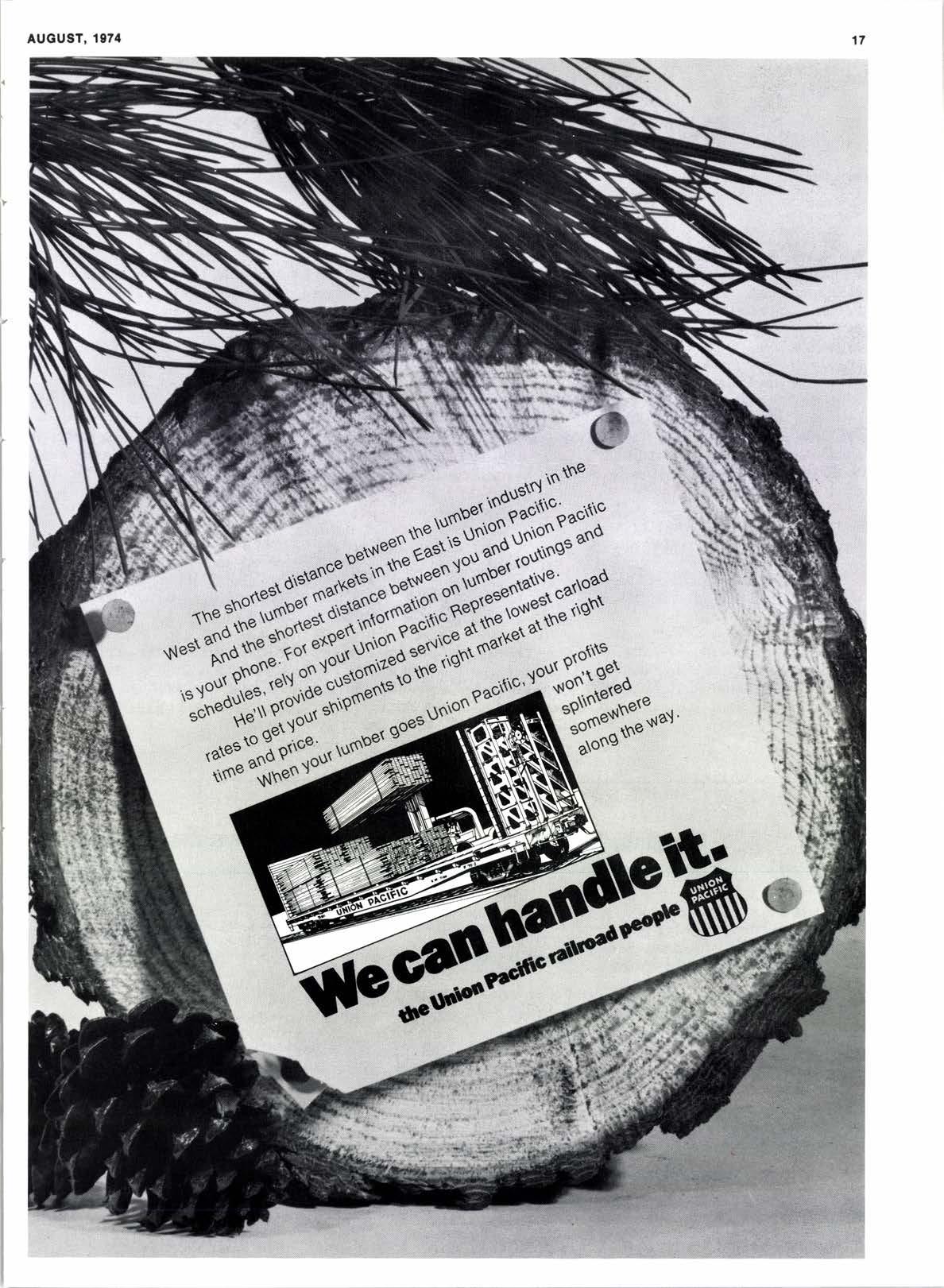
3 minute read
Optimism keys annual plywood association meeting
A N OPTIMISTIC picture of 11 plywood's future through the next 30 years was projected by American Plywood Assn. exec. v.p. Bronson J. Lewis at their recent 38th annual meeting in Portland.
Speaking before a record attendance of 780, Lewis warned, however, that realization of a brighter tomorrow will demand "rewriting of the old product definitions."
He added: "We're moving rapidly forward to a time when we'll have panels of various compositions - not sharply defined product categories, such as plywood, particleboard or hardboard."
The next 10-15 years will see increasing acceptance ofnew types of products, among which could be "plyboard," with various combinations of wood veneer and extruded wood fiber, he observed.
Lewis forecast production of as much as 36 billion sq. ft. of plywood and all other types of panels in the year 2004. (Softwood plywood production in 1973 was 18.3 billion feet.)
It was not unlikely there would eventually be one major panel association for these types of products - "a single entity for promotion, quality testing and technical services," he said.
Noting that plywood industry growth in the past has come from identifying similarities rather than intensifying differences or competing by species, region or panel composition, he added, "that may be the same way to grow in the future, by identifying what we have in common as well as understanding our differences."
He pinpointed the main thrust of today's wood products industry research as emphasizing the most efficient uses for wood fiber - "uses that will help solve our raw material supply problems and at the same time lead to superior products."
In a wide-ranging assessment of the future, Lewis also predicted that by the year 2004, "most of the environmental issues which the wood industry currently faces will be resolved."
Also ahead, he said, is steadily increasing emphasis on international trade. "We will be getting more and more veneers from all parts of the globe, and manufacturing products for homes in Africa and all around the world." Other predictions: government will exert even more influence on business in the future, and the marketplace correspondingly less"in 2Cf,4, consumerism will be politicized to the point where we will have to prove a new product is a step forward and non-wasteful before it goes on the market."
Concluded Lewis: "Yesterday waste was unwise, today it is immoral and tomorrow it will be illegal."
APA has commenced planning for a Twenty-first Century Seminar on the wood products business. It will bring together nationally known forecasters, manufacturers, analysts, distributors, and other experts "for a hard, specific look at where the
Story at a Glance
New product types, such as "plyboard", composed of various materials foreseen as well as soaring plywood usage "most present environmental issues will be solved bY 2004" wood products business is really gging in the future."
The association is sticking with plywood production forecasts based on housing starts of about 1.7 million in 1974 and 2.05 million in 1975. APA earlier forecast softwood plywood industry production of about 17.1 billion sq. ft. in 1974, recovering to about 18.7 billion feet next year.
Lewis said that for these forecasts to be realized, "we're looking for a home building turnaround in second half 1974, with increased momentum thereafter."
He added that while a turnaround is still "fully capable of realization," firm governmental relief for housing is needed immediately.
"The federal government holds the key, with its continuing tight squeeze on mortgage money avail- ability through the Federal Reserve Board," he said.
Lewis said he looked to the government "to snap out of its inertia in these next few weeks, and to put some real muscle behind the lip service we've been hearing on aid to housing. If relief is not forthcoming, and soon, we could very likely see a postponement of the housing recovery to a point where all 1974 and 1975 forecasts would be meaningless. We could see the national economy in a nosedive from which it might not easily recover."
The new officers elected are: chairman of the board of trustees, John A. Ball, Jr., Champion International; president, William C. Smith, Timber Products Co., Medford, Or.; v.p., John M. Richards, Potlatch Corp., Lewiston, Id.
William C.
Smith elected new president.
Among new trustees elected to the board are: John J. Connors, Simpson Timber Co.; Don Deardorff, Fourply, Grants Pass, Or.; Hayden Dorsey, Medford Veneer & Plywood, White City, Or.; E.W. Hughes, Boise Cascade; Quay Jorgensen, Centralia Plywood & Veneer Co., Centralia, Wa.; C.R. Kalahan, Weyerhaeuser Co.; Peter H. Koehler, Evans Products, Aberdeen, Wa.; Frank V. Langfitt, Jr., Georgia-Pacific; S.E. Pittman, Bohemia Inc., Eugene, Or.; E.L. Quirk, Southwest Forest Industries, Phoenix; and Douglas A. Westenhaver. Jr.. LouisianaPacific. Portland.











